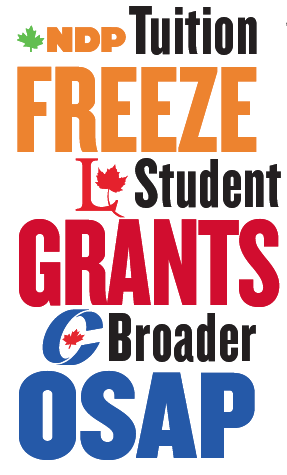Jacqueline Perlin
Assistant News Editor
As Ontarians cast their votes October 6, many remain uncertain of their choices. Platforms are built to be attractive, but which party is really the best pick for students?
Gregory Albo, a political science professor at York, expresses what he believes are the most important issues students should consider when heading to the polls.
Besides the obvious debate over tuition, two issues stand out.
“The complete lack of funding of public transit including the building of subways in all of our major cities in Ontario has really reached a crunch, and the question is really whether we’re going to improve that capacity,” says Albo. “This involves the provincial government stepping back into funding capital expenditures and operating expenditures.”
He says students should also consider which party will take steps to address youth employment.
“Graduates leaving university right now and citizens without university degrees are in the worst employment situation in almost 60 or 70 years,” he says. “We’re seeing little focus or effort at all to deal with the employment problems of new graduates and young people as a whole.”
Ultimately, Albo believes the NDP offers the best overall platform for students. It proposes a tuition freeze while bringing per-capita university funding in line with the Canadian average. Ontario has the lowest per-capita program spending in the country.
“That would be a significant expansion and probably come to an order of $1 billion being put into the university sector,” he notes. While the NDP has not specified how it will raise their funds, Albo says this is a problem with all the Ontario parties.
“[Lack of costing] is not unusual to the NDP and the problem is that [all the parties] are working within a similar fiscal framework,” he says. “The Tories have more tax cuts and fewer spending increases, but if you actually look at it, it’s really general variations within the same approach.”
Moreover, he points out that the Liberal party’s tuition grant program is “merely symbolic.”
“They’re not necessarily going to stop the level of tuition fee increases and […] the logical thing to do would be to increase funding. So it appears that this is a step towards a further way of market-izing Ontario universities,” says Albo.
He notes this grant fails to provide uniform access to all students in all parts of the province, as it only targets undergraduate students with a family income below $160,000.
“[Uniformity] was the objective of how the university system was set up in Ontario in the 1960s when it was expanded, and it’s essentially a reversal of that,” says Albo. “This is an attempt to continually tier the Ontario university system.”
The Conservatives, Albo says, are no better.
“The Tories are basically not suggesting much change in the structure at all,” he says. “They have minor changes but basically it’s a status-quo approach.”
Nevertheless, Albo emphasizes that none of the parties are offering enough.
“The party platforms are disappointing across the board,” he says, calling his endorsement of the NDP the choice of the “lesser of three evils.”
“You’re dealing with […] a bad group that aren’t going to address the longer term problems of underfunding of the public sector in Ontario.”



